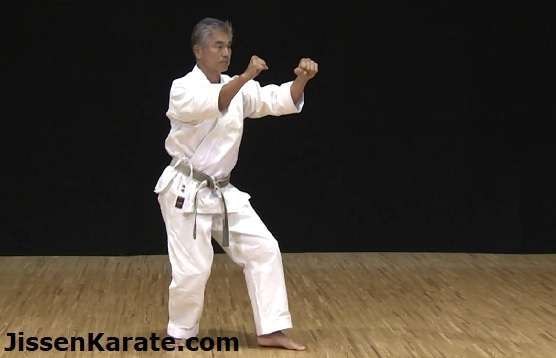As I delve into the history and origins of Kata Jion 慈恩, it becomes evident that there is limited available information about this particular Kata.
The belief is that the roots of this Kata can be traced back to China, primarily due to the presence of the term “Jion,” a Buddhist term documented in ancient Chinese texts. Some assertions suggest that the name may be derived from a temple known as Jion-Ji, translating to “Jion Temple,” where martial arts were reportedly practiced. Subsequently, this martial art form found its way to Tomari in Okinawa.
In the second edition of “Karate-Do Kyohan”, published in 1973 by Gichin Funakoshi, there’s an intriguing quote that could provide insight into this mystery:
“This is the original name, and the character for it has appeared frequently in Chinese literature since ancient times. The Jion-ji is a famous old Buddhist temple, and there is a well-known Buddhist saint named Jion. The name suggests that the kata was introduced by someone identified with the Jion Temple, just as the name of Shorin-ji Kempo is derived from its connection with the Shorin Temple.”
Let’s break down the quote:
“This is the original name, and the character for it has appeared frequently in Chinese literature since ancient times.”
-
- This indicates that the name “Jion” or its character has been present in Chinese historical records or literature for a long time. Its longstanding appearance suggests that the term or concept associated with “Jion” holds significance in Chinese culture or history.
“The Jion-ji is a famous old Buddhist temple, and there is a well-known Buddhist saint named Jion.”
-
- This part provides context. It explains that “Jion-ji” is an old, renowned Buddhist temple. There is also mention of a notable Buddhist saint named Jion, linking the name directly with Buddhist tradition and history.
“The name suggests that the Kata was introduced by someone identified with the Jion Temple, just as the name of Shorin-ji Kempo is derived from its connection with the Shorin Temple.”
-
- This part of the quote draws a parallel between the naming conventions of martial arts forms and their potential places of origin or inspiration. The suggestion here is that just as the martial arts form “Shorin-ji Kempo” is named after the “Shorin Temple” due to its association, it’s possible that the Kata Jion was introduced or is associated with someone from the Jion Temple. This doesn’t confirm the origin but offers a theory or hypothesis based on naming patterns.

In conclusion, the quote provides a theory about the origin of the Kata Jion, suggesting that its name might be linked with the Jion-ji Temple or the Buddhist saint named Jion. This relationship between martial arts forms and temples or religious figures emphasizes the deep connection between spiritual practices and martial arts in many Asian cultures.
Interpretation of the word “Jion.”
There exist various ways to interpret the word “Jion,” and some of these alternatives are presented here for consideration as potential interpretations.
慈恩: “Mercy of Love”.
- Ji 慈: Translates to mercy; compassion; clemency; pity; charity; benevolence; and love.
- On 恩: Translates to grace, kindness, goodness, favor, mercy, blessing, and benefit.
Some individuals attempt to use this interpretation to establish a connection between “Jion” and China. However, it’s worth noting that numerous temples in Japan are named “Jion” and employ the same kanji spelling for their names. Given the widespread use of “Jion” as a temple name, even if “Jion” were named after a temple, determining which one would be a formidable challenge.
寺音: “Temple Sound”.
- Ji 寺: Translates to temple, a Buddhist temple.
- On 音: Translates to sound; noise.
This interpretation could imply the sound of a temple bell ringing.
寺恩: “Mercy of the Temple”.
- Ji 寺:Translates to temple, a Buddhist temple.
- On 恩: Translates to grace, kindness, goodness, favor, mercy, blessing, and benefit.
The interpretation of Jion is: “Mercy of Love,” “Temple Sound,” or “Mercy of the Temple.”
Let’s take a closer look at the kanji 慈恩.
The term “慈恩” in Chinese, when pronounced as “Cí ēn (Jion),” can be translated as “Compassionate Grace” or “Merciful Kindness.” It is often used as a name for temples, monasteries, or religious institutions in China, particularly in the context of Buddhism.
For example, you might find temples named “慈恩寺” (Cí ēn Sì), which would translate to “Temple of Compassionate Grace” or “Temple of Merciful Kindness.” These names reflect the emphasis on compassion and benevolence that are central to Buddhist teachings.
There are likely several temples or religious institutions with names containing “慈恩” throughout China.
Sister kata.
Ji’in (“Temple Ground”) and Jitte (“Ten Hands”) were most likely developed in Okinawa and are not of Chinese origin. Looking at these two kata, there are significant similarities to Jion, which indicates that they probably were developed out of Jion at a later time.
Conclusion.
As we delve into the history and meanings of Kata Jion, it becomes evident that this kata holds captivating connections to China. Its origins remain cloaked in mystery, with theories suggesting the influence of Buddhist temples and the possibility of its introduction to Okinawa during the mid-18th century, possibly originating from China. Alternatively, it’s plausible that Jion might have been created by one of the Okinawan to-te masters of that era. While the precise origin may forever remain unknown, the enduring legacy of Kata Jion serves as a profound reflection of the intricate history of martial arts, encompassing both Chinese and Okinawan influences.
Thank you for taking the time to read my article.
Gert
